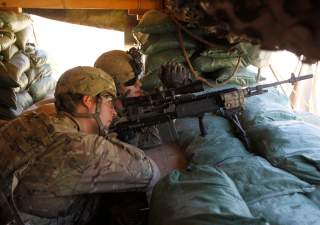The M-14 Rifle Won't Quit After Sixty Years
It was the U.S. Army's last battle rifle.
Key Point: The M-14 is still carried into war by U.S. soldiers, even older models.
Critics said the M-14 was what happened when the U.S. government took many years and spent millions of dollars designing a rifle that was really just a glorified M-1 Garand from World War II.
The M-14 was the U.S. military’s last battle rifle. It appeared in 1959—the contemporary of the Pentagon’s first jet fighters and ICBMs. With its heavy steel parts and walnut stock, the M-14 looked positively archaic.
It was hardly a Space Age weapon. And it only endured as America’s battle rifle until 1970, when the M-16 completely superseded it—the shortest service record of any U.S. military rifle in the 20th century.
Yet, the M-14 has come and gone and come back again. Its accuracy and power—it fires the 7.62 x 51 millimeter NATO round—have given it a new lease on life as a weapon for snipers and designated marksmen.
The M-14 refuses to surrender.
“The M-14 has re-appeared in recent years in the hands of U.S. troops,” Alan Archambault, former supervisory curator for the U.S. Army Center of Military History, tells War Is Boring. “The sniper version is designated the M-25 and has proven to be very effective in Iraq and especially Afghanistan.”
“I believe the M-14 was a better weapon for combat where accuracy and range are more important than volume of fire,” says Archambault, an Army veteran. “This is why some troops in Afghanistan have used the M-14.”
Truthfully, the story of the M-14 is the story of how the Army wanted to build a better Garand.
The M-1 Garand was rugged, reliable and semi-automatic—even the Germans with their reputation for technological prowess were still issuing their troops the bolt-action Karabiner 98k, which was just another incarnation of the rather old-fashion Mauser.
But the Garand wasn’t a select-fire weapon. The German Sturmgewehr 44 assault rifle with its full-auto capacity—and firing a lighter round—startled military men on both sides of the Atlantic.
The U.S. Army, however, wanted to stick with the .30-caliber round, convinced that no other cartridge could hold its own on the battlefield. What the generals really wanted was a full-auto version of the M-1.
Also, they wanted a new rifle as a replacement for four common infantry weapons—the Garand, the M-1 Carbine, the M-3 Grease Gun and the M-1918 Browning Automatic Rifle. The idea was to get more bang for the buck.
Starting in 1945, the Army began testing several experimental rifles including the T-20—one of John Garand’s designs—plus the Springfield T-44 and even an early version of the Fabrique Nationale FAL, the Free World’s answer to the Soviets’ popular AK-47.
In the end, the Army adopted the T-44 in 1957, designating the weapon “United States rifle, 7.62-millimeter, M-14.”
But there were production delays, and by 1961 the 101st Airborne was the only unit fully equipped with the weapon.
What’s more, there were rising doubts about what the M-14 could really do.
On full-auto, the M-14 fired 750 rounds a minute, leading to complaints that it was nearly uncontrollable as a select-fire weapon. The Army eventually added locks to some M-14s, preventing soldiers from switching the weapon to full-automatic fire.
Also, by 1962 a Defense Department report cast doubt on whether the M-14 would ever be the all-purpose weapon it was supposed to be. Critics said the 7.62-millimeter NATO round was too powerful for the Grease Gun’s submachine gun role and too puny to serve as a light machine gun to replace the BAR.
But the Vietnam War was heating up, so the M-14 went to war. Soon there was no doubt that the M-14 could fire a round right through jungle concealment, killing the enemy and sometimes even exiting the body of the first enemy soldier to kill the Viet Cong guerrilla behind him.
“The M-14 was a powerful rifle, but heavy and somewhat awkward to use in close-in jungle fighting,” Archambault says. “It was also found that the wood stocks of the M-14s would swell in the jungle humidity and effect accuracy.”
Besides, the Defense Department was beginning its love affair with the early version of the M-16—and the M-16 looked and felt like a Space Age weapon.
By 1966, the military began replacing M-14s with M-16s in Vietnam. The M-14 rifle remained the standard rifle for Army basic training as well as for U.S. troops in Europe until 1970.
But the M-14 enjoys a busy post-retirement career. It remains in use by ceremonial units like the Army’s Old Guard, a ceremonial unit that makes regular appearances at White House events and during burials at Arlington National Cemetery.
And the M-14 still goes to war. More than half of the small arms engagements in Afghanistan are beyond 500 meters, with the enemy employing heavier weapons and then withdrawing before NATO air support or artillery fire can arrive.
In addition, the Taliban takes advantage of the country’s peaks and valleys to engage U.S. and allied forces at distances beyond the effective range of the 5.56-millimeter cartridge the M-4 carbine and M-16 rifle both fire.
The Army’s solution was to pull thousands of old M-14s out of armories, clean off the cosmoline and attach telescopic sights to weapons that were new when the soldiers’ and Marines’ grandfathers joined the military.

